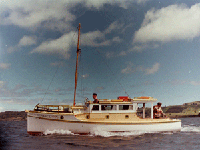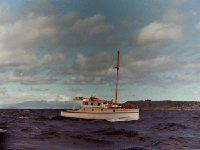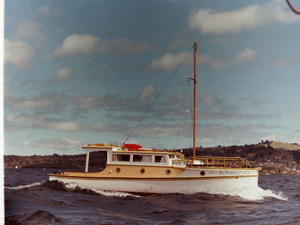Rainbow
- In 1930 a newspaper article described a new boat being built.
- "A beautiful craft is now ready to take to the water at Chas Robinson's boat-building yard at Ohinemutu. Its design is novel to Rotorua and embodies the latest devices to ensure safety, comfort and speed. The vessel is built to the order of CB Smith of Hamilton and is for use on Lake Taupo and the upper reaches of the Waikato".
- The Rainbow had along and close association with Rainbow Point. The Smiths were the first family to live there. Betty Steel who still lives at Rainbow Point can remember first coming to Taupo in 1926.
- Betty's father who had the Rainbow built, wanted a family project. He liked Taupo and decided to build a holiday home at Rainbow Point. In those days it was all manuka & scrub. He couldn't afford the total cost so his brother from Wellington came in as a partner. For years the Smiths were the only family living there and it is only in the last 50 years that it has been sub-dived and built on.
- As well as building their house for which they had to supply their own power and water, the family also built a boat shed, jetty and ramp. When she was used she would be winched down the ramp on the cradle and brought back up for storage. The jetty, ramp & boatshed are no longer there, victim to government regulations which saw them being dismantled over 30 years ago.
- The Smiths used the Rainbow for private use on the lake. They had trips over to the boa harbour and Tokaanu. Betty's father was very fussy about the weather and would study it before going. She was a very well known sight on the lake with her distinctive coloured canvas and flag flying.
- For a description of the Rainbow once again a reference to the newspaper article written at the time at the time gives an interesting insight into boats at the time.
-
- "Details of its construction reveal extensive departures from the traditional lines. Most noticeable to the ordinary observer is the exaggerated flair. The bow deck line is almost the full width of the boat up to a foot or so from the stern, giving a tremendous lifting power in a seaway. It is very attractive. The underwater forward lines follow traditional design but from a third of her length from the bow the floor is almost square to the bilge turn and flat. A light dead wood deepening to ten inches aft gives good steering control. The internal arrangements is a new departure. The hull is all room. A plate glass windshield extends from gunwhale to gunwhale with a rake aft to protect it from heavy seas. The engine is in the centre of the boat and housed in a louvred cabinet the topof which forms a table. In the rear of the engine is a cross thwart with the steering wheel occupying the same relative position as in a motor car. All the engine controls are to the lefthand of the helmsman and are operated without moving from the moving from the wheel. There is complete freedom of movement and when desired, camping accomodation is provided by four seats that can be adjusted as bunks. All the internal fittings are of oiled and varnished oak, very handsome and useful. No detail has been missed and a fire extinguishing equipment is installed in the most accessible position. A feature of construction is the canopy which is carried on haevy tubular nickled rodsabove the major portion of the hull from the forward windscreen. This gives all the protection of a fixed deckhouse without its disabilities. It enables the occupiers to have absolute freedom of movement and at the same time security should bad weather arise. The craft is unsinkable having been fitted with copper air tanks with a buoyancy capacity equal to the dead weight of the engines and fittings. Deck fittings are in bright work and the hull white enamel, red underwater body, with black boottopping, all beautifully finished. Metal work is all heavily nickled over copper.
- The upholstery by Mr W Pakes is in keeping with the general excellence of the craftsmanship of the builders. The dimensions are 25ft overall, beam 7ft 6", with aworking draft of 20 inches. These figures do not give an adequate impression of the roomliness of the vessel.
- The engine is a gray 6-cylinder 40 HP motor which, on the lines of the craft should give twelve knots or over. A very handsome vessel and a credit to the designer and also an example to the management of the round trip as to how a modern passeneger carrying craft could be built and equipped to be in keeping with the demands of the times in the matter of lake transport."
Rangatira
-
Rangatira is often associated with the well known writer Zane Grey who regularly visited New Zealand for fishing in the 1920s.
-
As well as deep sea-fishing waters he also visited Taupo and mentions that in his book The Anglers Eldorado. While here he spent most of his time fishing at Waihora Bay. He used the Rangatira for deep-sea fishing in the Bay of Islands. Many believed he owned her but this was not so. He had a similar boat Frangipani built for him which he eventually shipped back to Honolulu.
-
Rangatira was originally called the Otehei. She was built by Collings and Bell in Auckland for the Arlidge Brothers from the Bay of Islands. They used her and a couple of other boats similar to her for deep-sea fishing. Rangatira was the first of three built and was named after Otehei Bay in the Bay of Islands.
-
The government then owned her for a short time but in the late 1930s she was bought by two New Plymouth publicans, Ulander and Power, and it was they who brought her to Taupo.
-
Donald Hunt leased her for a season and ran her commercially, but during the war she was laid up in Taylor's back yard.
-
In 1946 Don McLeod leased her from Ulander who was not the sole owner. After being out of the water for a number of years the seams had opened up and she needed a good deal of maintenance to put her back in condition again. Don carried out these repairs as well as doing some alterations. The dodger was extended to cover most of the cockpit, a galley put in and Jack Taylor built a wheelhouse on her.
-
Don ran her for ten years with Ron Houghton as skipper. In the mid 1950s Ulander sold her to Ivan Vickery who ran her until the late 1960s when she was sold to the Bay of Islands' Deep Sea Fishing Club.
-
Thirty-six feet long, she is an all-kauri boat. The original cabin ran back from the foredeck on one level and there was a small dodger. She was a hard chine boat with a rounded bottom which was unusual in Taupo before World War II. She also had a small flare on her. Originally she was powered by a 110hp Redwing petrol engine which gave her a speed of 10 to 12 knots.
-
When Don McLeod took over the lease he decided the engine was not worth reconditioning so he put in a Scripp V8 and this was not replaced until Ivan Vickery put in a Ford diesel.
-
When Zane Grey used her for deep-sea fishing in the Bay of Islands, he had a weather vane put on her mast in the shape of a swordfish and this was still there when she came to Taupo.
-
Zane Grey spent some time in New Zealand fishing and used to come here in style on his own ship which was the size of the old Interisland ferry Maori. There were five launches attached to his ship.
-
The Rangatira is now back in the Bay of Islands as the Otetei, being restored to its former style in the days when Zane Grey enjoyed his deep-sea fishing.
- Ranui
-
- Ranui started her sailing career in Rotorua after the Second World War. Built by M Crawley, an Auckland boat-builder, she was a gift to the Queen Elizabeth Hospital in Rotorua. This was a Returned Services Hospital which used Ranui to take convalescing soldiers for trips on Lake Rotorua.
- Known then as El Alamein she was an open boat with a small cabin and a bunk room up forward. When the hospital was closed in 1952, Ranui was put up for tender. Ron Martin was the successful tenderer and had her for two years before selling her to one of Taupo’s old-time residents - Noel East. Noel put on a full cabin and was first to have her surveyed.
- The next owner was from Hawke's Bay and used her privately before selling her to one of Taupo's most familiar commercial boat operators - Jim Storey. He had Ranui surveyed and used her for many years, taking visitors out on Lake Taupo for fishing and sightseeing excursions.
- In 1980 the present owner, Graham Twiss, bought her.
- Apart from much repainting, Ranui has had no renovations and still has the original kauri hull and superstructure that Noel East put on.
- She is powered by a Perkins diesel which gives her 78hp and a speed of nine knots - originally she had one of the familiar Grey Marine engines. She is licensed to carry 23 passengers plus the captain.
Romance
- Romance used to be moored in the boat harbour, a derelict with nothing in her apart from a few floorboards and a few little seats. She didn't have the cabin that is now on her and every time it rained very hard the floorboards would float round in the bilge water. People would go past and say there isn't much romance left in her now. That was in 1974 before she was bought by the Drake family. They stripped her right down to her bare hull, re-ribbed her and started again. Although the bottom planks had been submerged in water since 1914 there was nothing wrong with them and although there was some rot in the knees the planking was totally sound.
- Romance hadn't been used much since the 1950s until she was re-launched in 1976 after a 14-month refit. Five thousand man hours went into her which included replacing the air-cooled Lister engine with a Chrysler marine, modifying the cabin, putting in the laminated beams, repainting and many other time-consuming repairs.
- Romance was built by the well-known boat builders, Bailey and Lowe, in Auckland in 1914. She was built for a Mr Mills and was moored in Shoal Bay. In the early 1920s she went to Napier where she was used for fishing trips. She was owned by Sydney Hole the dentist. The great earthquake left her high and dry in 1931 and she was brought to Taupo in the same year.
- Jack Taylor ran her as a commercial tourist launch until just after the war. On his house in the boat harbour he had painted on the roof "Jack Taylor for Romance". He also built the Victory at this time and there are similar features which indicate that Victory's design was influenced by Romance.
- Romance went through a series of private owners until the Drakes bought her in 1974. She has always been called the Romance but used to be a flush-deck launch. Jack Taylor built a cabin on her and the Drakes have made the cabin bigger.
- She is 26ft 6in long with a beam of 7ft and built with fine lines so she slides easily through the water. When they built this type of boat at the turn of the century they only had small engines. The Romance is heavy, weighing 3½ tons.
- A great many people remember her as a commercial tourist launch and once out on the lake a man hailed the owners asking if he could take their photograph as he knew a lady from Capetown who spent her honeymoon on Romance in 1937. He said she would appreciate the photo to see that the Romance was still going.
-
Rothesay was built in 1911 by Bailey and Low in Auckland for a Mr Heather who was a member of the Auckland Harbour Board. During World War I she was used as a patrol boat by the Navy. The Internal Affairs Department took her ovand used her as a ranger’s boat on Lake Taupo until the late 1930s when she was put up for tender.
-



Rothesay
- Rothesay was built in 1911 by Bailey and Low in Auckland for a Mr Heather who was a member of the Auckland Harbour Board. During World War I she was used as a patrol boat by the Navy. The Internal Affairs Department took her ovand used her as a ranger’s boat on Lake Taupo until the late 1930s when she was put up for tender.
- In 1938 Don McLeod (not to be confused with Don and Cleo McLeod) was holidaying in Taupo and liked it so much that he decided to stay here. He wanted to buy a boat and put in a tender for the Rothesay which was accepted.
- She was in bad condition. She had been let go and there were rotten planks to be replaced. As well as repairing the hull, Don built a wheelhouse, raised the cabin and added the sponsors on the side to give a wider deck. Her planked hull was kauri as was the cabin.
- Rothesay is 32ft long and is a narrow beamed boat. She is one of what was called an “old toothpick” boat. They were very long and the term "narrow gutted" meant they weren't very wide for the length, in comparison with boats today. The standard for old boats like her was for the beam to be a quarter of the length of the boat. (Rothesay was 8ft 6in wide.) They were built like the Maori canoes and were built to do a reasonable speed (7-8 knots) for very little power.
- Don plied for hire in her up to the late 1950s. She was used for day and overnight trips as well as for longer trips that sometimes lasted up to one month. One group regularly booked her right through March, camping in Western Bay. Mostly though, the visitors slept aboard. There were four berths on her plus sleeping accommodation for the skipper.
- There are many other stories about this popular boat that Don can tell. She was a very popular boat in her time, flying her flag with her name on it. Many a time overseas visitors booked a day trip on her and with a fine day and good fishing, decided to spend a week and cancel their bookings elsewhere.
- Rothesay left Taupo when Don sold her in the late 1950s and apparently she is now used as a fishing boat in Auckland.
Royce
- Royce is a family boat, built in Whangarei about 50 years ago. Its history is a little obscure. She was bought by her present owner, Rex Tindall, ten years ago and had been used by the previous owner for fishing on the Manakau Harbour.
- When Rex bought her she was in a rough condition. The boat has always had the same profile and apart from painting her white (she was originally blue and white) and putting a mast on her, she has changed very little. In fact, her name has never changed.
- Royce is 20ft long with a beam of 7ft. She has an all-kauri dodger and cabin. Powered by a four cylinder Continental engine, which gives her a top speed of seven knots, she rides very well on the water and is a steady boat for the lake.
- Royce is run from the dodger at the back and has been modified to make her easier to handle. She has two bunks but no cooking facilities on board.
- Rex Tindall comes from Christchurch. He has always been interested in boats but it was only when he came to Taupo fifteen years ago that he was able to get the opportunity to buy one.
- Royce was brought down from Auckland on a tandem trailer. Rex has done all the work on her and has had her out of the water several times doing his own maintenance.
Ruahine
Ruahine's heyday was in the 1920s. She was called the Whizzbang and was then considered to be the fishing boat if you wanted to catch fish. She had a good reputation and was owned and skippered by Mr White. Ruahine was a bit different then to what she is now. The bow and cabin top have been raised.
In the 1920s it would cost four pounds ten shillings for a day's fishing and five pounds if you wanted to go round to the Western Bays. Ruahine didn’t have a dodger then, just a straight cabin, so in those days if people went out for the night they usually slept in tents ashore. She may have slept a few, but there weren’t many facilities aboard her as there are on today’s commercial fishing launches.
Ruahine used to be powered by a one-cylinder engine which was well known for its pop-pop sound. She was thus called the Whizzbang. Now she has a 4-cylinder diesel.